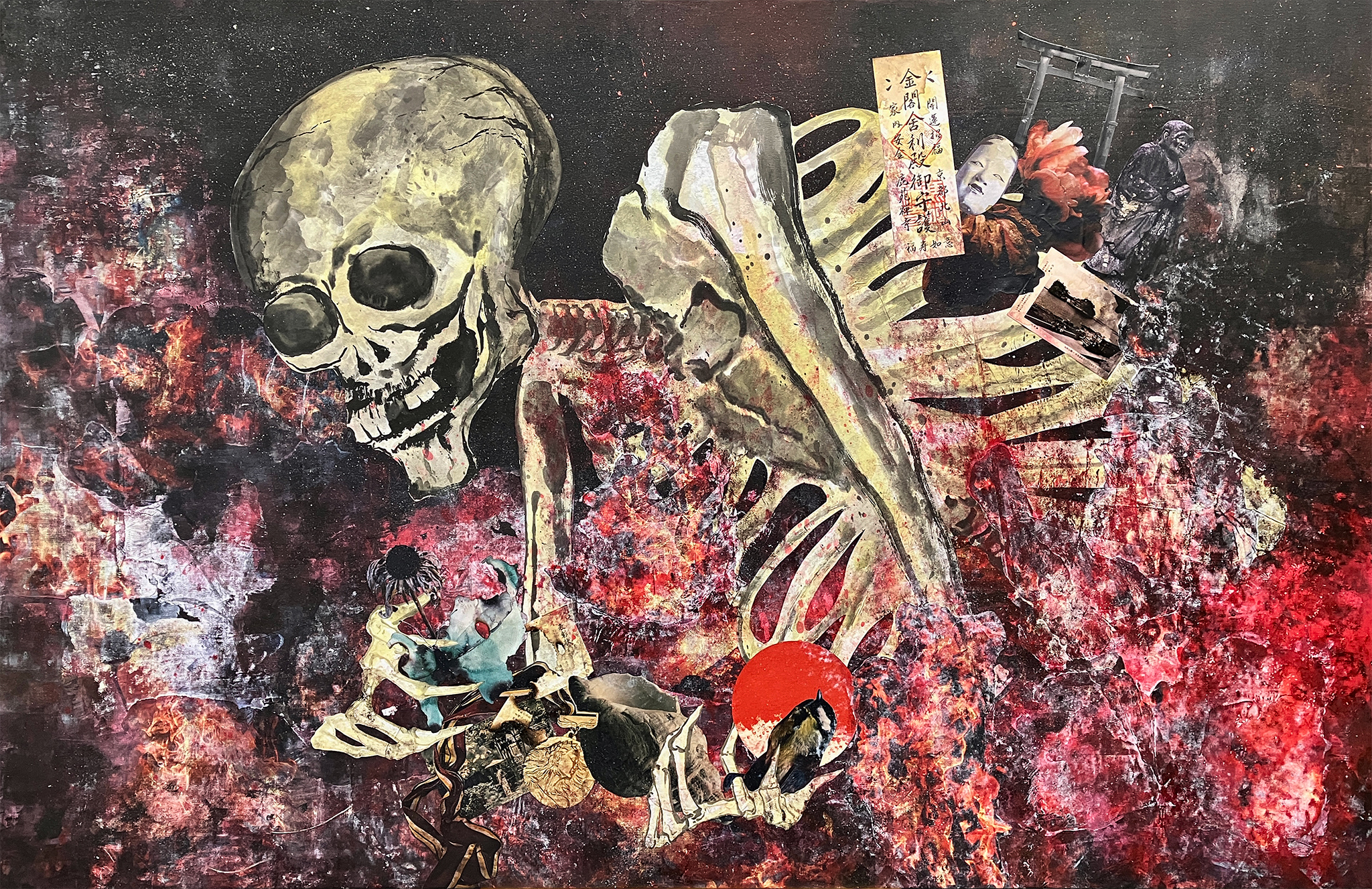
Obsession Skeleton
44”x65” (acrylic, ink painting, collage on canvas ) March 2022
This piece was inspired by a story and by observing friends and family who became consumed by vanity and the pursuit of honour. I saw how this obsession led to their downfall, and that realisation pushed me to create a massive skeleton.
It explores emotional attachment, and how clinging to the past—nostalgia, the so-called glory days, and treasured memories—can slowly become a burden. Over time, these attachments grow into something overwhelming, like a giant skeleton weighed down by what once seemed precious. Eventually, they find themselves trapped in a self-made hell, unable to break free.
I found a similar symbolism in Japanese Ukiyo-e, especially in Utagawa Kuniyoshi’s depictions of skulls. Inspired by his work, I painted the skeleton using ink and various types of tea to evoke a sense of age and decay.
As I collected material and developed the composition, I gradually gave clearer form to these ideas of emotional weight and fixation, letting the “precious things” take shape as symbolic objects.
The background is layered with flames, Higanbana (flowers from the other shore), and other elements created through pad printing and collage, adding to the sense of ritual and emotional intensity in the final piece.
My Room

I have always loved imagining myself shrinking to a tiny size and wandering through different corners of my home.
My bed is on the upper bunk. Lying there, I can feel the surrounding walls, yet at the same time, the space seems to dissolve, losing all boundaries. It feels as if I am floating outside, sensing the warmth of the sun penetrating through the walls. Below is my activity space, where through two windows, the moon has long been waiting in the sky. Anime posters cover the walls, and books of various kinds fill every remaining inch.
This was my childhood sanctuary—my room.
The objects and spaces depicted in my artwork are more than mere memories; they represent a breakthrough in thought—a challenge to the Western principle of perspective, where objects appear “larger when near and smaller when far.” It is a cultural dialogue and confrontation between East and West. In traditional Eastern painting, artists often follow a different logic for perspective—sometimes depicting objects as “smaller when near and larger when far” or disregarding perspective entirely.
This perspective is not just theoretical; it stems from my personal experiences and observations. When I bring a book close to my eyes while looking into the distance, my peripheral vision perceives the book as smaller than the faraway scene. This suggests that different ways of viewing the world lead to different modes of thinking.
Through my work, I aim to preserve the unique experiences and thoughts from my childhood. My artistic approach references the style of David Hockney, incorporating Eastern perspectives while intertwining my own life experiences—the significance of my room as a symbol of my past, as a native Hong Konger, the abrupt shift to living in the UK, and the questions of self-identity and cultural belonging.
EXIT
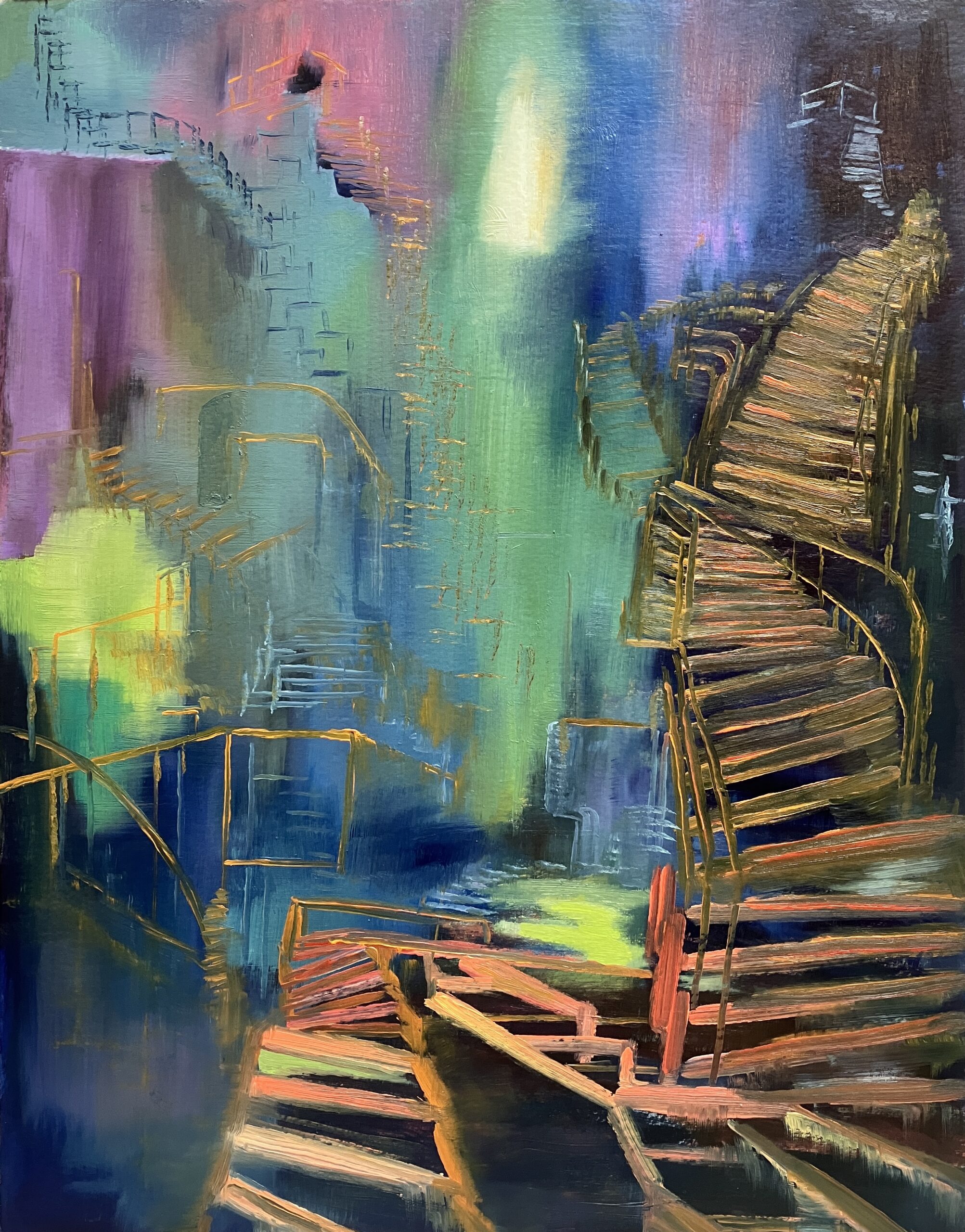
“Finding the Exit Within” is a theme that deeply resonates with many. I perceive the inner world as vast and fantastical—an endless space I have been exploring for decades and continue to navigate.
With each step forward, I build new paths. The more I persist in moving ahead, the more landscapes I encounter, bringing me closer to an ideal destination—an “exit” that represents a sense of clarity and fulfilment.
In this painting, I use highly saturated colours, allowing them to contrast and enhance one another, creating a luminous, almost “neon” effect on the canvas. I love the sense of movement and uninhibited emotion it conveys—a feeling of wild, untamed energy rushing forward.
BLUE

In this piece, blue takes centre stage as the dominant colour. I aim to challenge the conventional perception of the so-called “blue period” and present my own interpretation—one that breaks through its limitations.
As a child, I wasn’t allowed to paint blue apples or blue clouds, though I never really understood why. Yet, it is precisely this “blue period” of mine that has allowed me to understand human fragility while also strengthening my resilience.
I have scattered the symbolic elements—apples, clouds, and restrictions—throughout the composition. In this painting, they appear as if they were brushed or imprinted onto the canvas, their fragmented and incomplete nature allowing them to blend seamlessly with the deep blue background rather than standing apart. Horizontal and vertical brushstrokes intersect across the surface, evoking the passage of time, year after year.
I seek joy behind worries, happiness beyond pain. At the heart of my work is the idea of thriving in adversity, growing resiliently despite the challenges.
Golden Nightmare
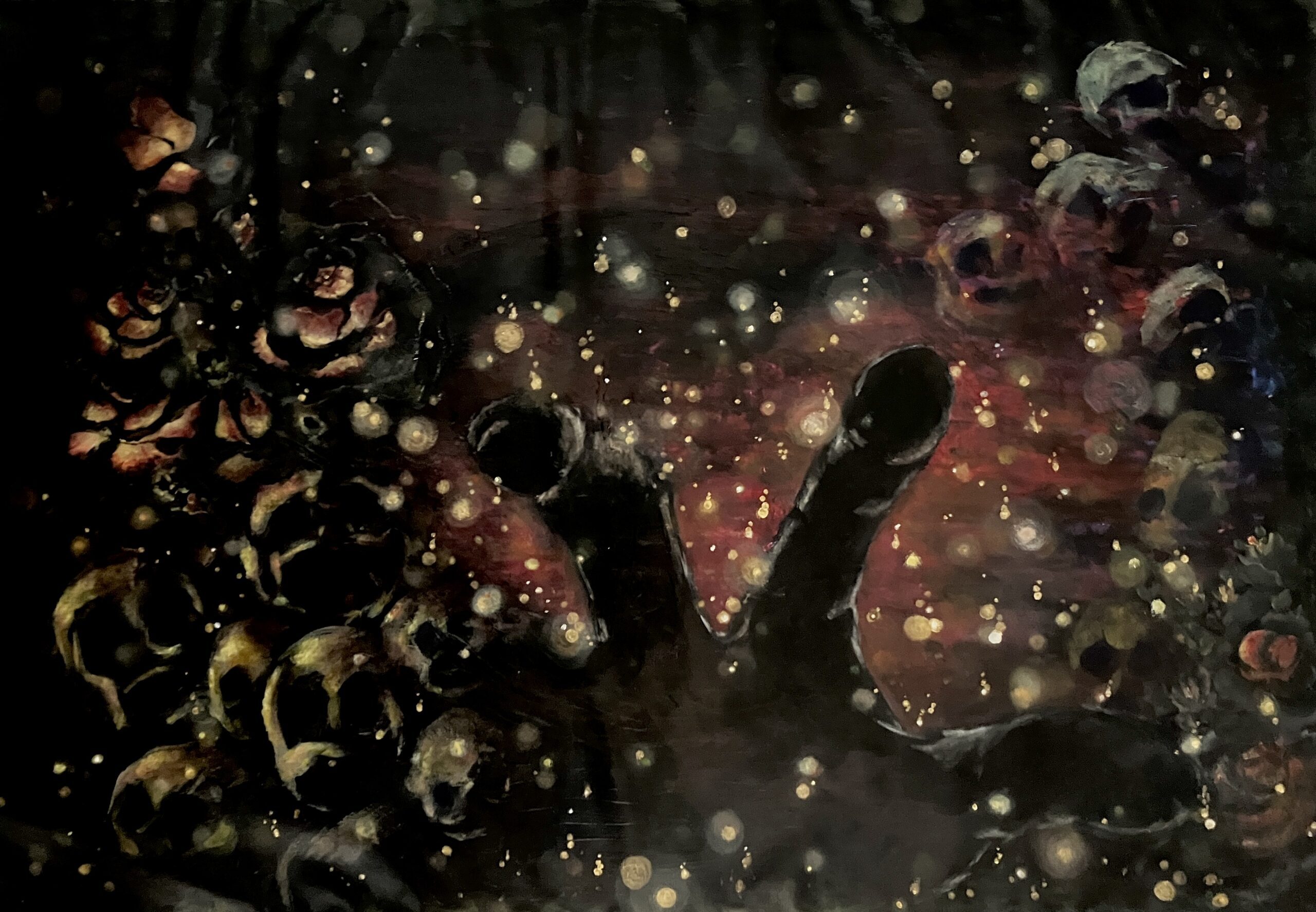
This piece embodies the fusion of creativity and perception, transforming real objects—flowers—into a vision of a nightmare. The idea that “a nightmare feels as real as reality, yet exists only in our imagination” is fascinating. I chose withered snapdragons, which resemble skulls, and combined them with the surreal beauty of Midnight Ember Roses. Their eerie glow creates an ethereal atmosphere, where every element is carefully considered for both its visual impact and deeper meaning.
Darkness and eternal brilliance coexist—they are born together, fade together, and rise again in an endless cycle. Yet, most people only perceive one aspect at a time. The same thing can hold multiple meanings, but we often choose to see only one side.
In this painting, the nightmare takes form through flowers that are not inherently frightening, darkness that is not truly menacing, and an imposing hand that carries no real threat. Yet, when combined, they evoke fear. We cannot control whether nightmares come, but their power is something we assign them—shaped by our experiences and perceptions. If we learn to see the other side, we can find resilience, even in darkness. Here, the nightmare represents fears born from within—manifestations of our own mindset.
“The nightmares that emerge from within are like the incomprehensible vastness of the universe—yet, they hold the potential to create eternal brilliance. In the depths of endless darkness, one can find a golden will, a golden strength.”
Candle – Green Background
Candle – Red Background
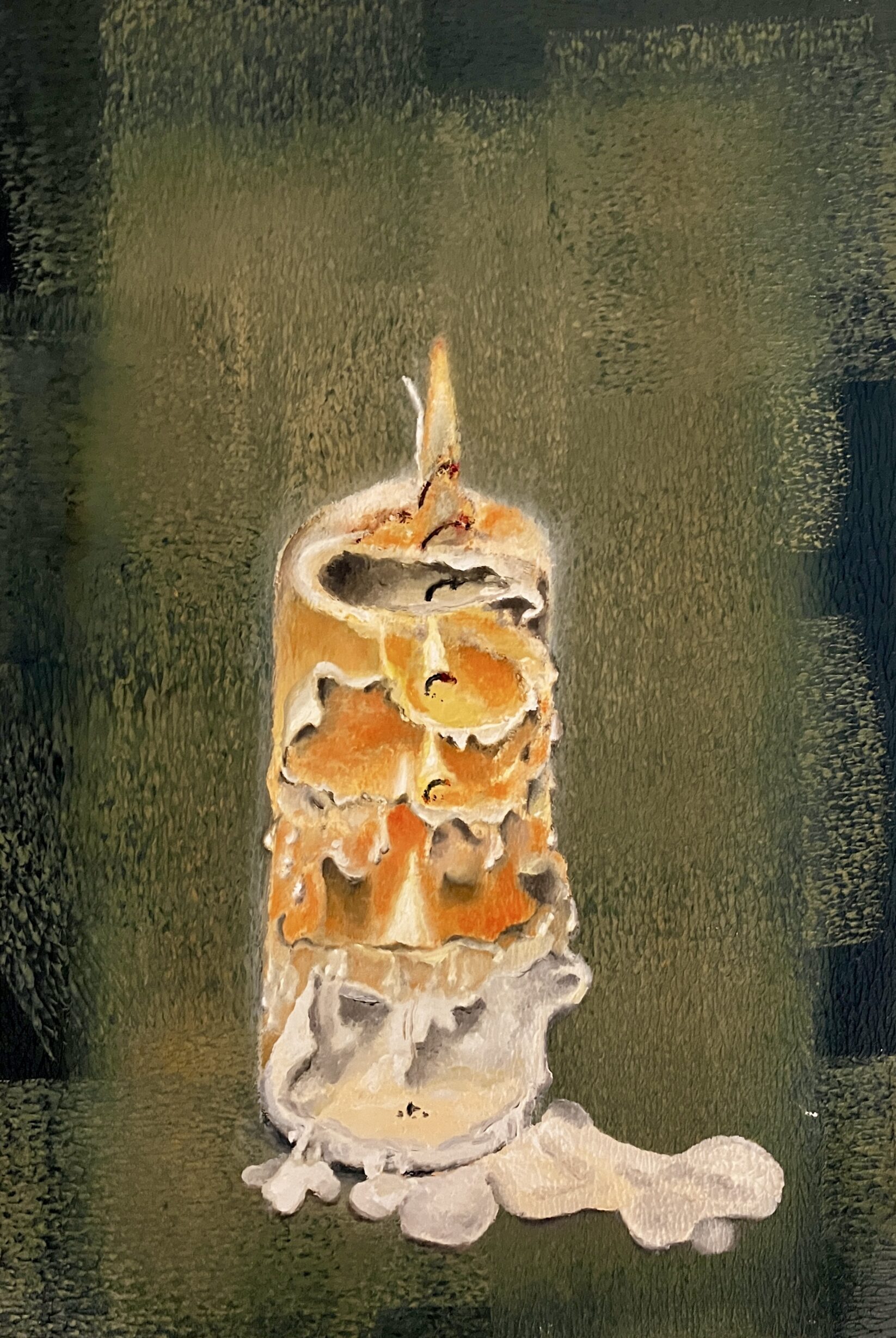
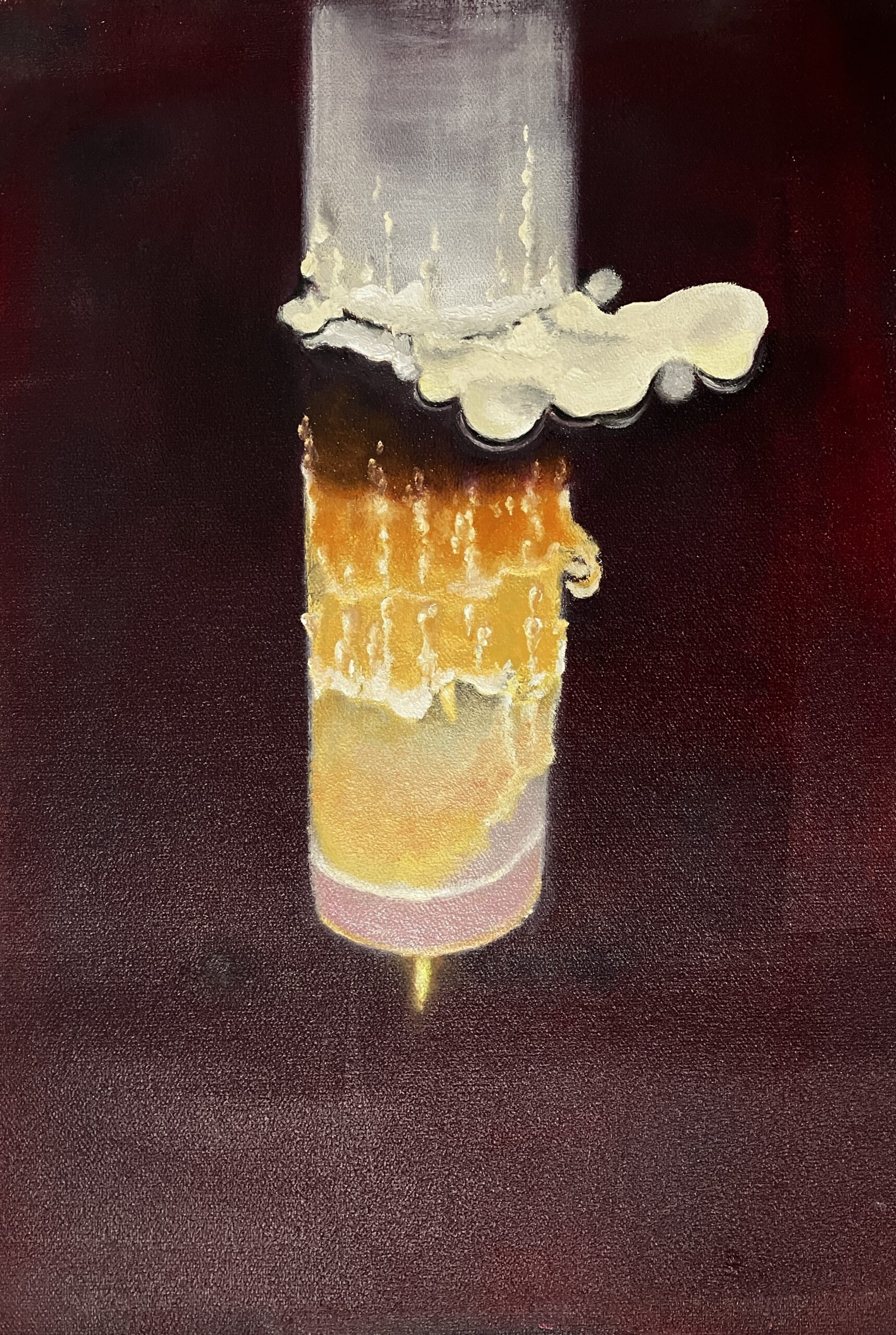
The Candle’s Reflection: A Montage of Time and Identity
These two paintings depict the same candle, using it as a metaphor for life and the passage of time. By layering and overlapping different moments of change, I create a montage effect that blurs the boundaries between transformation and continuity.
In Candle—Green Background, the candle represents the ever-changing nature of life. With each stage of existence, we evolve—but are we still the same person after all these changes? The candle’s wick alternates between being lit and extinguished, reflecting the shifting light and shadows that shaped and enhanced its dreamlike quality. I carved the candle in multiple layers to create a surreal sense of depth, revealing hidden dimensions of time. The multiple wicks, appearing to fall away, further emphasise the fluidity of time’s passage.
In Candle—Red Background, we see a reflection of the first painting. However, upon closer inspection, the two candles are vastly different. The in-multiple-layers candle is now a pure, untouched white, blending seamlessly with the surrounding darkness. It is no longer clear whether it is a solid object or simply an illusion. Meanwhile, the reflection candle is multi-layered, dripping with wax, and illuminated in vibrant hues. The stark contrast between them challenges the idea of reflection; this juxtaposition reflects the way our inner thoughts and outward actions may not always align, yet they are still part of the same person.
Through these paintings, I explore the impermanence of life. We often become deeply attached to our experiences, overwhelmed by emotions tied to each moment. But when we step back, we realise that, like everyone else, we are simply moving through the natural cycle of birth, aging, sickness, and death. There is no need to hold on too tightly to the fleeting nature of reality.
Hong Kong Scenery
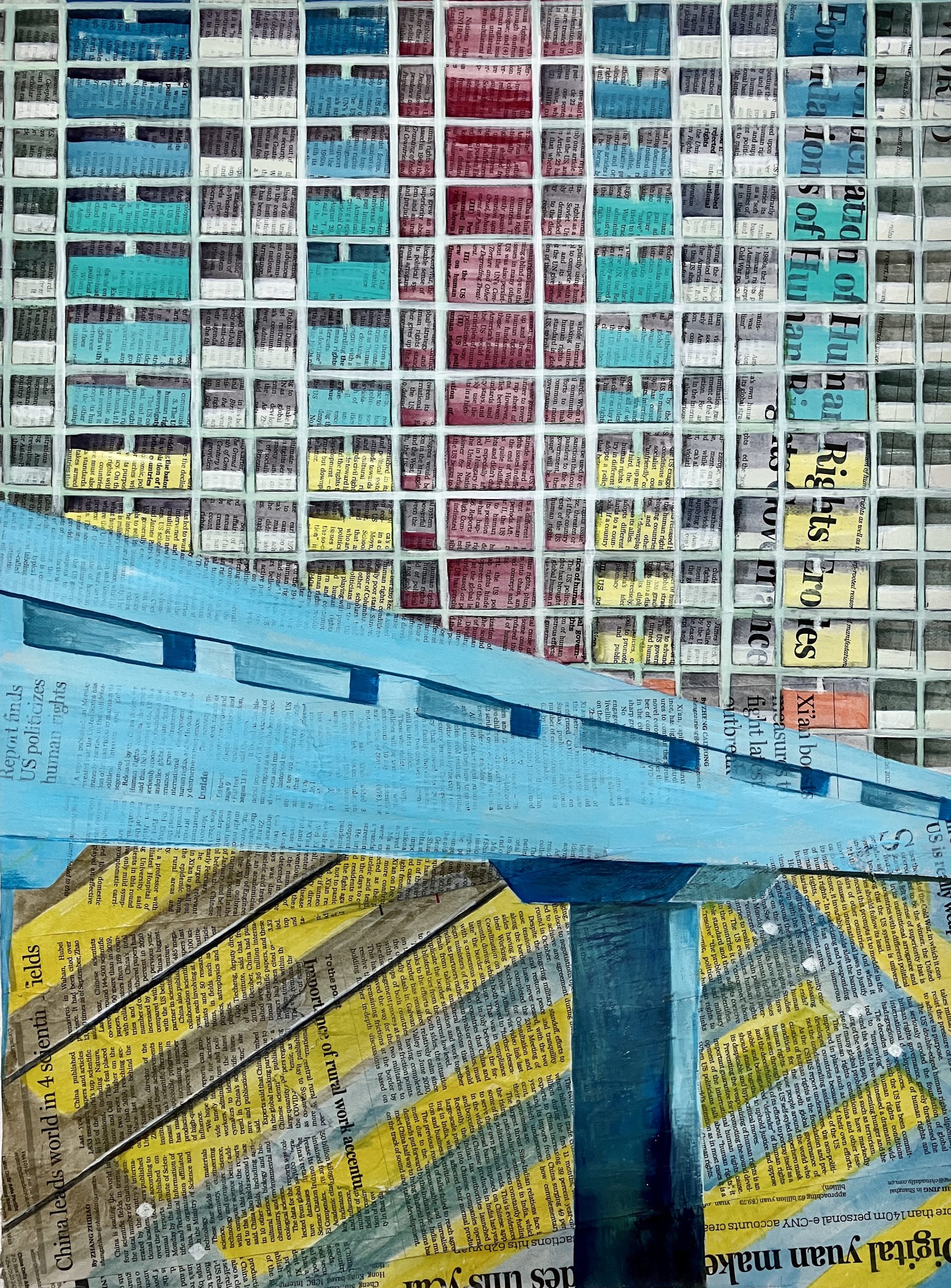
The use of an English-language newspaper as the foundation of the artwork is a deliberate choice—it reflects the colonial history and lasting Western influence on Hong Kong. By painting three distinct locations over the newspaper background, I aim to highlight the unique cultural and historical significance of each place within the context of a constantly evolving city. This approach offers a poetic way to capture Hong Kong’s complex identity.
The three locations depicted are:
– Choi Hung Estate (meaning “Rainbow Estate” in Chinese)
–
Shek O – Blue Bridge (also known as Lover’s Bridge)
– Queen’s Road (specifically the zebra crossing in Central)
Choi Hung Estate is a vivid example of how social media can draw attention to things we might have once overlooked. The rainbow-colored buildings, now iconic and widely recognized, weren’t always celebrated. Growing up in Hong Kong, it’s easy to pass by such places without a second thought. It’s refreshing to rediscover beauty in our everyday surroundings.
Shek O’s Blue Bridge, perched on the southeastern edge of Hong Kong Island, is beloved for its scenic views and romantic atmosphere. Also known as Lover’s Bridge, it’s a popular destination for stargazers and photographers alike. The bridge offers an unobstructed view of the night sky, making it a peaceful escape from the city’s hustle.
Queen’s Road is one of the oldest and most important roads in Hong Kong. Built in the 1840s and named after Queen Victoria, it symbolizes the city’s colonial past. Today, it lies at the heart of the city’s financial and commercial districts—a symbol of Hong Kong’s prosperity and transformation.
